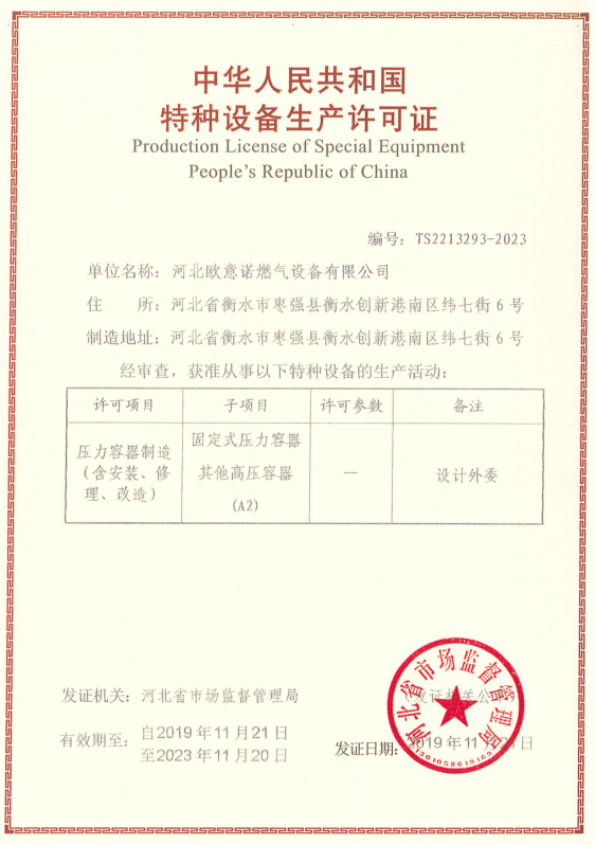
9 月 . 25, 2024 18:05
Back to list
وعاء الضغط
Understanding Pressure Vessels Their Importance and Functionality
Pressure vessels are critical components in various industrial applications, serving as a container designed to hold gases or liquids at a pressure substantially different from the ambient pressure. Their design and manufacturing require adherence to strict engineering standards due to the inherent risks associated with storing substances under pressure. This article delves into the principles, applications, and safety considerations surrounding pressure vessels.
Definition and Design Principles
A pressure vessel is typically defined as a container designed to operate at pressures either higher or lower than the atmospheric pressure. Crucial to their safety and functionality, the design of pressure vessels involves several factors, including the type of material, operating temperature, and pressure rating. Common materials used in their construction include carbon steel, stainless steel, and various alloys, chosen for their strength and resistance to corrosion and fatigue. The design process also considers the geometry of the vessel, such as whether it is cylindrical, spherical, or conical, as these shapes distribute stress more evenly.
The design of pressure vessels is governed by various codes and standards such as the ASME Boiler and Pressure Vessel Code (BPVC), which outlines the requirements for manufacturing, testing, and operating pressure vessels safely. These guidelines help ensure that the vessels can withstand the required pressures without failure, thus protecting both personnel and equipment.
.
Pressure vessels are ubiquitous across many industries, including oil and gas, chemical processing, power generation, and food and beverage. In the oil and gas sector, for example, pressure vessels are used to store and process various hydrocarbons under high pressure, which is critical for the efficient extraction and refinement of oil. In the chemical industry, they play a vital role in reactors, distillation columns, and heat exchangers where reactions or separations occur under elevated pressures and temperatures.
وعاء الضغط

In the food industry, pressure vessels are essential for the sterilization of canned goods, ensuring that food products are safe for consumption by eliminating harmful bacteria. The pharmaceutical industry also relies on pressure vessels for processes like autoclaving, where items are sterilized using steam under pressure.
Safety Considerations
Despite their essential role in industrial processes, pressure vessels pose significant safety risks. The failure of a pressure vessel can lead to catastrophic events, including explosions or ruptures, resulting in loss of life, environmental damage, and significant financial repercussions. Therefore, rigorous safety protocols are critical in the lifecycle of a pressure vessel, from design and construction to maintenance and inspection.
Regular inspections and maintenance are essential for identifying potential issues before they escalate. Non-destructive testing (NDT) techniques, such as ultrasonic testing or radiography, help detect flaws or weaknesses in the vessel's material without compromising its integrity. Additionally, pressure relief valves are installed to prevent overpressure situations by providing a safe outlet for excess pressure.
Conclusion
In conclusion, pressure vessels are indispensable in modern industrial applications, facilitating the safe storage and processing of gases and liquids under pressure. Their design and maintenance adhere to strict safety standards to mitigate risks associated with high-pressure operations. As industries continue to evolve and demand safer, more efficient processes, the role of pressure vessels will undoubtedly remain paramount. Understanding their complexities, applications, and safety measures is crucial for anyone involved in fields that utilize these critical components. With continued advancements in materials and engineering practices, the future of pressure vessels looks promising, driving innovation while ensuring safety and reliability in industrial operations.
Latest news
-
Unlocking The Quality Gas Pressure ReducersNewsNov.01,2024
-
The Role of Gas Pressure Reducing StationsNewsNov.01,2024
-
The Importance and Functionality of Safety Relief ValvesNewsNov.01,2024
-
The Essential Role of Safety Valves in Natural Gas ApplicationsNewsNov.01,2024
-
The Essential Role of Gas Pressure RegulatorsNewsNov.01,2024
-
Enhance Your Premium Gas FiltersNewsNov.01,2024

